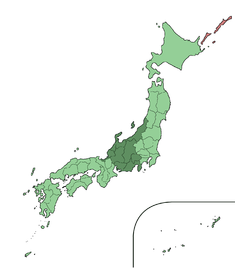Chūbu region


Chūbu (中部地方, Chūbu-chihō) is the central region of Honshū, Japan's main island.
The Chūbu, or central region, encompasses nine prefectures in the midland of Japan, west of the Kantō region: Aichi, Fukui, Gifu, Ishikawa, Nagano, Niigata, Shizuoka, Toyama, and Yamanashi.
The region is the widest part of Honshū and is characterized by high, rugged mountains. The Japanese Alps divide the country into the Pacific side, known as the front of Japan, or Omote-Nihon sunny in winter, and the Sea of Japan side, or Ura-Nihon, the back of Japan, snowy in winter.
The region comprises three distinct subregions.
Hokuriku (北陸), a coastal strip on the Sea of Japan that is a major wet-rice producing area. The road through Hokuriku region was Hokurikudō (北陸道).
The Central Highland (中央高地), commonly called Koshin (甲信), an inland region between Hokuriku and Tōkai. The roads through Central Highland were Nakasendō (中山道) and Kōshū Kaidō (甲州街道).
Tōkai (東海), the eastern seaboard, a narrow corridor along the Pacific Coast. The road through Tōkai region was Tōkaidō (東海道).
Hokuriku region lies north of the massive mountains that occupy the central Chūbu region. The district has a very heavy snowfall and strong winds in winter. Its turbulent rivers are the source of abundant hydroelectric power. Niigata Prefecture is the site of domestic gas and oil production. Industrial development is extensive, especially in the cities in Niigata and Toyama Prefectures. Fukui and Ishikawa Prefectures also have large manufacturing industries. Hokuriku's development have owed markets in historically Kansai and recently Kantō regions as well as Tōkai region. Its port facilities are mainly to serve trade with Russia, Korea and China. In winter its roads are sometimes blocked by snow. Niigata's transportation with Toyama used to be geographically limited and had strong influence from Kantō region. Because of these Niigata Prefecture is often classified as Kōshinetsu region with Nagano and Yamanashi Prefectures of the Central Highland.
The Central Highland is an area of complex and high rugged mountains--often called the roof of Japan--that include the Japanese Alps. The population is chiefly concentrated in six elevated basins connected by narrow valleys. Tosan was long a main silk-producing area, although output declined after World War II. Much of the labor formerly required in silk production was absorbed by the district's diversified manufacturing industry, which included precision instruments, machinery, textiles, food processing, and other light manufacturing. Prefecturally it is Yamanashi, Nagano, and northern Gifu Prefectures.
The Tōkai region, bordering the Pacific Ocean, is a narrow corridor interrupted in places by mountains that descend into the sea. Since the Tokugawa period (1600-1867), this corridor has been important in linking Tokyo, Kyoto, and Osaka. One of old Japan's most famous roads, the Tōkaidō, ran through it connecting Edo (Tokyo, since 1868) and Kyoto, the old imperial capital; in the twentieth century, it became the route of new super-express highways and high-speed railroad lines. Prefecturally it is Shizuoka, Aichi, southern Gifu and Mie Prefectures. The latter three prefectures are also called Chūkyō region.
A number of small alluvial plains are found in the corridor section. A mild climate, favorable location relative to the great metropolitan complexes, and availability of fast transportation have made them truck-gardening centers for out-of-season vegetables. Upland areas of rolling hills are extensively given over to the growing of mandarin oranges and tea. The corridor also has a number of important small industrial centers. The western part of Tōkai includes the Nobi Plain, where rice was grown by the seventh century A.D. Nagoya, facing Ise Bay, is a center for heavy industry, including iron and steel and machinery manufacturing.
It is located between Kantō and Kansai, and includes the major city of Nagoya as well as long Pacific and Sea of Japan coastlines, extensive mountain resorts, and Mount Fuji.
See also
| This image is available from the United States Library of Congress Prints and Photographs Division under the digital ID {{{id}}} This tag does not indicate the copyright status of the attached work. A normal copyright tag is still required. See Wikipedia:Copyrights for more information. |

